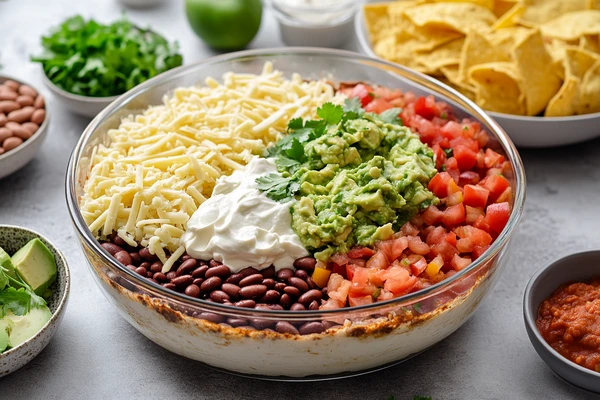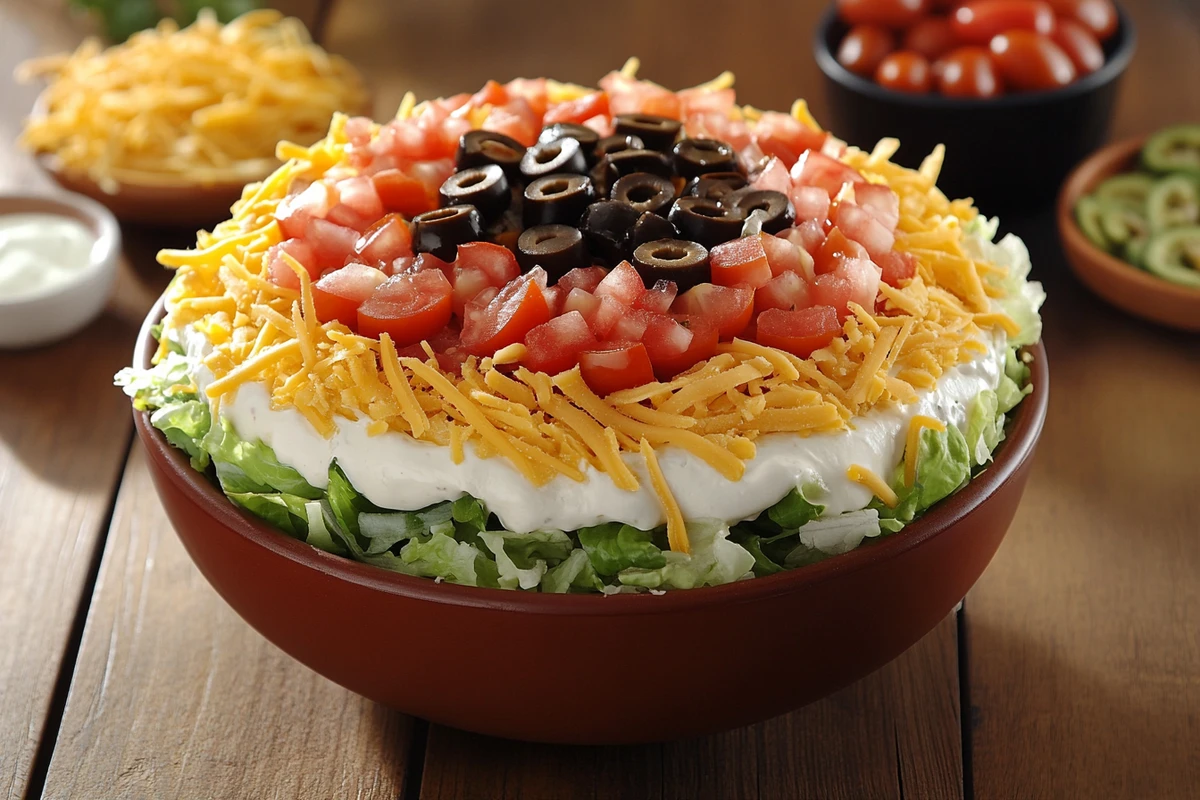Nothing is more disappointing than preparing a delicious taco dip for a gathering, only to find it swimming in water minutes later. If you’ve been asking yourself, “Why does my taco dip get watery?”, don’t worry—you’re not alone. Understanding what causes this problem and how to fix it will ensure your dip stays perfectly creamy and appetizing every time.
Introduction
If you’ve ever served taco dip at a party and noticed it gets watery after a while, you’re not alone! Why does my taco dip get watery is a common question among home cooks and party hosts. The good news? This issue has specific causes, and with a few adjustments, you can prevent your delicious dip from turning into a soggy mess.
Taco dip is a favorite appetizer loved for its creamy layers and fresh ingredients, but factors like moisture from vegetables, dairy content, or improper preparation can lead to excess water. In this guide, we’ll dive into the top reasons behind this issue and give you practical solutions to keep your taco dip perfect every time.
What Causes Taco Dip to Become Watery?
A watery taco dip can happen for a few key reasons, and pinpointing these issues can help you avoid the frustration. Here are the most common causes:
1. Excess Water in Fresh Ingredients
Vegetables like tomatoes, lettuce, and onions are packed with water. While they bring freshness and flavor, they also release moisture over time, especially if they are not properly drained or dried before being added to your dip.
2. Dairy Products That Separate
Sour cream and cream cheese are essential for a creamy taco dip, but not all types behave the same. Low-fat or reduced-fat dairy products are more prone to thinning and releasing water compared to full-fat options, which are naturally more stable and creamy.
3. Temperature Changes
Leaving your taco dip at room temperature for too long can cause condensation, especially if the dish starts to warm up. This moisture can mix into the layers, creating that undesirable watery texture. Serving the dip chilled helps maintain its consistency.
4. Poor Layering Technique
Layering matters more than you think. Placing watery ingredients, like diced tomatoes or lettuce, directly on top of the creamy base allows moisture to seep into the other layers. Proper layering can help keep everything firm and intact.
By addressing these factors: moisture in ingredients, dairy stability, temperature, and layering, you’ll be well on your way to keeping your taco dip smooth, creamy, and free from unwanted water.
How to Prevent Taco Dip from Getting Watery

The good news is that with a few simple adjustments, you can keep your taco dip creamy and perfectly textured. Here are the most effective tips to avoid a watery mess:
1. Drain and Dry Your Vegetables
Fresh vegetables like tomatoes, lettuce, and onions are major contributors to excess water in taco dip. To fix this:
- Tomatoes: Dice them and place in a strainer to remove excess liquid. Sprinkle a little salt to draw out excess moisture, let them sit for about 10 minutes, then pat them dry with a paper towel.
- Lettuce: Rinse and dry the lettuce thoroughly using a salad spinner or paper towels.
- Onions: Finely chop onions and blot them dry with a paper towel to remove any surface moisture.
2. Choose the Right Dairy Products
The type of dairy products you use makes a big difference.
- Opt for full-fat sour cream and cream cheese instead of reduced-fat or low-fat options. Full-fat versions have a thicker consistency and are less likely to release water.
- Allow cream cheese to come to room temperature before mixing so it blends smoothly without breaking down.
3. Layer Ingredients Properly
Proper layering prevents water from seeping into the creamy base. Here’s the ideal order:
- Start with a thick layer of cream cheese or sour cream mixed with taco seasoning.
- Add ingredients like beans or guacamole, which act as a barrier.
- Place watery vegetables (like tomatoes and lettuce) on top to keep moisture from spreading into the lower layers.
4. Keep It Chilled
Temperature plays a big role in maintaining taco dip consistency.
- Serve the taco dip cold whenever possible. The chill keeps the dairy layers stable and prevents water from forming.
- Store the dip in an airtight container in the refrigerator until serving time. If you’re preparing it in advance, wait to add watery toppings like tomatoes or lettuce until just before serving.
5. Avoid Overmixing
Overmixing ingredients like sour cream and cream cheese can break down their structure and cause them to release water. Gently fold or mix the layers just enough to combine them.
6. Serve in Smaller Portions
If you’re serving taco dip at a party, consider presenting it in smaller portions instead of one large dish. This way, you can keep backup portions chilled until needed, reducing the chances of the dip sitting at room temperature for too long.
By following these tips, you’ll ensure that your taco dip remains fresh, creamy, and water-free. With a little extra care during preparation, every layer will stay perfectly balanced for everyone to enjoy.
Draining Ingredients: A Key to Success
Draining excess moisture from ingredients is one of the most effective ways to prevent your taco dip from getting watery. Below is a handy guide to draining common taco dip ingredients properly:
| Ingredient | Why It Gets Watery | How to Drain It Effectively |
|---|---|---|
| Tomatoes | Tomatoes are naturally high in water content. | Dice the tomatoes, place them in a strainer, sprinkle with a little salt, and let them sit for 10 minutes. Pat dry with paper towels. |
| Lettuce | Excess water clings to lettuce leaves. | Use a salad spinner to remove water after rinsing. Alternatively, pat dry thoroughly with paper towels. |
| Onions | Chopped onions release surface moisture. | Finely chop onions and blot them dry using paper towels before adding them to the dip. |
| Guacamole | Avocado naturally holds some moisture. | Prepare guacamole with less liquid (limit lime juice or salsa) and keep it chilled to prevent extra moisture release. |
| Beans (Refried) | Some canned beans can be overly moist. | Drain any liquid from canned refried beans and mix until thick. Avoid adding excess liquids like salsa. |
Why Draining Ingredients Matters
Watery ingredients add unwanted moisture, which seeps into the creamy layers and breaks down the structure of your taco dip. By properly draining and drying each component, you can maintain a stable and appealing consistency.
Pro Tip:
If you’re short on time, place chopped vegetables on paper towels, press gently, and let them sit for a few minutes. The towels will absorb most of the moisture quickly.
By following these simple steps, you can drastically reduce water content and keep your taco dip looking and tasting fresh for longer.
Layering Techniques for Perfect Consistency
Proper layering is an often-overlooked secret to achieving a firm and creamy taco dip. A well-thought-out approach can prevent water from seeping between layers, maintaining both texture and flavor. Here’s how to layer your dip like a pro:
1. Start with a Solid Base
The first layer sets the foundation for your taco dip. A thick base of cream cheese or a sour cream mixture works best because it acts as a barrier against moisture from other ingredients.
- Mix softened cream cheese with taco seasoning for added flavor and a firm consistency.
- Spread it evenly across the bottom of the dish to ensure no gaps where moisture could collect.
2. Add Thicker Layers Next
Ingredients like refried beans or guacamole should go in the second layer. These ingredients are thicker and more stable, which helps reinforce the base.
- Refried beans: Make sure they’re fully drained and spread evenly.
- Guacamole: Use a thick, creamy version of guacamole and spread it without overmixing.
3. Keep Moisture-Prone Ingredients on Top
Ingredients that release water, such as tomatoes, lettuce, and onions, should always be added last. By placing them on top, any moisture that seeps out will stay in that layer instead of running into the creamy base.
- Dice tomatoes, drain them, and pat dry.
- Use crisp, dry lettuce and sprinkle it gently to avoid clumping.
- Onions can be added sparingly to prevent excess moisture.
4. Spread Ingredients Evenly
Uneven layers can cause ingredients to mix prematurely, creating pockets where water can accumulate. Take your time to spread each layer evenly using a spoon or spatula.
5. Add Garnishes at the Last Minute
Garnishes like shredded cheese, olives, or jalapeños should be added just before serving to keep their texture and prevent moisture buildup. This step also ensures a visually appealing presentation.
Example of the Perfect Layer Order
Here’s a simple guide to layering your taco dip effectively:
- Cream cheese mixed with taco seasoning (base layer)
- Refried beans or guacamole (second layer)
- Shredded cheese
- Diced tomatoes and onions (fully drained)
- Crisp lettuce
- Garnishes like olives, jalapeños, or cilantro
By using this method, you’ll create a beautiful, multi-layered taco dip that stays fresh and firm for hours. Each bite will offer a perfect combination of flavors and textures without a hint of unwanted water.
Frequently Asked Questions (FAQs)
1. Why does my taco dip get watery after a few hours?
Your taco dip becomes watery due to excess moisture from ingredients like tomatoes, lettuce, or onions. If these ingredients are not properly drained or dried before being added, they will release water over time, especially when sitting at room temperature.
2. Can I use low-fat sour cream and cream cheese in taco dip?
While you can use low-fat options, they are more likely to release water and separate because they have a higher moisture content. Full-fat sour cream and cream cheese are better choices for a thicker, creamier consistency.
3. How do I stop tomatoes from making taco dip watery?
To prevent tomatoes from adding excess moisture:
- Dice the tomatoes.
- Place them in a strainer.
- Sprinkle with a little salt and let them sit for 10 minutes to draw out water.
- Pat them dry with a paper towel before adding them to the dip.
4. Can taco dip be made in advance?
Yes, you can make taco dip in advance, but avoid adding moisture-prone toppings like tomatoes and lettuce until just before serving. Store the dip in an airtight container in the refrigerator to keep it fresh and creamy.
5. How long can taco dip sit out at room temperature?
Taco dip should not sit out for more than 2 hours at room temperature. After this time, moisture buildup and bacterial growth can compromise the dip’s texture and safety. Keep it chilled until serving.
6. Is it safe to freeze taco dip?
Freezing taco dip is not recommended because ingredients like sour cream and cream cheese tend to separate and become grainy after thawing. For best results, store the dip in the refrigerator and consume it within 2-3 days.
Conclusion: Enjoy the Perfect Taco Dip Every Time
A watery taco dip doesn’t have to ruin your gathering or your love for this delicious appetizer. By properly draining moisture-rich ingredients, using the right layering techniques, and following effective storage tips, you can ensure your dip remains creamy, fresh, and visually appealing. Small adjustments—like choosing full-fat dairy products and adding toppings at the last minute—make a big difference in both taste and texture.
With these tips in mind, you’ll never have to worry about serving a soggy taco dip again. Whether it’s game day, a potluck, or a family gathering, you can confidently serve a perfectly balanced and crowd-pleasing taco dip that everyone will love.
For a tried-and-true recipe, check out our Touchdown Taco Dip Recipe to impress your guests every time.
Enjoy your next batch of taco dip, and happy cooking!

